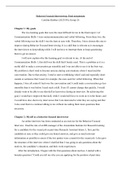Samenvatting
Book Summary - Applying Social Psychology 3rd Edition - From Theory to Intervention UU
- Vak
- Instelling
- Boek
This is a complete summary of the book 'applying social psychology' by Buunk, Dijkstra and van Vugt. I used the 3rd edition of the book.
[Meer zien]








